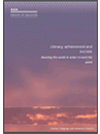This project was a collaboration between Te Whare Wānanga o Awanuiārangi (TWWoA) and the Ministry of Education (the Ministry). The aim of the project was to identify the transforming thinking, actions and practices that contributed to improved literacy and educational achievement. The project focused on the Hei Manaaki: National Certificate of Tourism Māori programme.
Methodology
The study was supported by kaupapa Māori theory, and used appreciative inquiry (Preskill, 2006). A kaupapa Māori perspective recognises that student success in one area must be understood in light of success in other areas. It considers the many elements that work together to contribute to improved outcomes. Both kaupapa Māori and appreciative inquiry consider improving the learning system as a whole, rather than focusing on problem finding, deficit thinking and "fixing" individuals.
At the start of the project, the research team developed a conceptual framework with the help of the programme leaders and teachers. A key assumption of the framework is that teaching and learning (including research) needs to be thought about as holistic, happening within a context and as political in nature. The production of knowledge is never neutral. It is, instead, a complex negotiation of knowledge, power and particular ‘regimes of truth’ which are constructed over time.
The framework set out the guiding principles for the research team, our relationships and behaviour toward each other as a research community, the research design, the data analysis and the knowledge produced from it.
At the time of the research, Hei Manaaki was delivered in a number of sites and contexts across Aotearoa. The project involved four case studies covering different areas and ways in which the programme was delivered. An analysis of the course work folder given to students provided further insights into the programme.
Key Results
From the education data
We conducted an analysis of the Literacy and Numeracy for Adults Assessment Tool (the Assessment Tool) and other education data to support this study. Learners were assessed in reading using the standard adult option of the Assessment Tool1. When analysing quantitative data from the 2011 - 2014 Assessment Tool and student achievement results, we found that:
• Hei Manaaki students are less likely to have school qualifications than students in other Level 3 and 4 certificates
• A higher proportion of Hei Manaaki students were assessed as having higher reading skills than in other Level 3 and 4 certificates. This may be a result of the Assessment Tool being administered later in the programme and as part the course.
• Reassessment in Hei Manaaki was targeted to those students who had lower levels of skill in their initial assessment. At each initial step level, a higher proportion of Hei Manaaki students who were reassessed made statistically significant gain, compared with other Level 3 and 4 certificates.
• The proportion of Hei Manaaki students passing most of their courses was uniformly high across all levels of reading skill. This contrasts with other Level 3 and 4 certificates where students with lower reading skill were less likely to pass most of their courses than students with higher reading skill.
From the qualitative research
At the initial research hui, teachers identified that to understand the literacy assessment results of their students, the research project would need to recognise that they were not focussing on literacy in their course. Their focus was on developing Māori tourism. This meant students being grounded in their place and having the essence of manaakitanga modelled to them in everything they did.
We found three main themes about how the programme contributed to student success:
• working together
• pedagogy
• knowledge development that links to purpose for study.
It was the combination of all three themes that was important, rather than an emphasis purely on any one of them.
Teachers emphasised that success in literacy is part of embedding literacy into the programme that is relevant to the students, and working from a base of strength and potential, which recognises and values the skills and knowledge that students bring with them. Manaakitanga, kaitiakitanga, whanaungatanga were values that were collectively shared and practiced. Literacy, numeracy and language acquisition were embedded aspects of the teaching and learning process, but students did not recognise that it was part of the programme. Assessments were treated as learning activities.
The work folder played a key role in supporting student success. The content was personalised using an icon of manaakitanga, someone who appeared throughout the folder called nanny Kui. Students were asked to connect the content and jargon of tourism with who they are, what they know and where they live. The work folder supported students through levels of literacy demands, starting quite light and getting progressively more complex. The literacy assessment was presented as another activity from the work folder. It was not treated as a separate piece of work, even when it was not contextually related to the course material.
Teaching and learning, including reading and comprehension, was a shared process (as opposed to individual) of making meaning, where teachers saw themselves as partners in learning with students. Individuals’ strengths were acknowledged and used in the process of working together to make and share sense. This supportive environment fostered high self-efficacy, and was essential to enabling this shared approach to teaching and learning.

